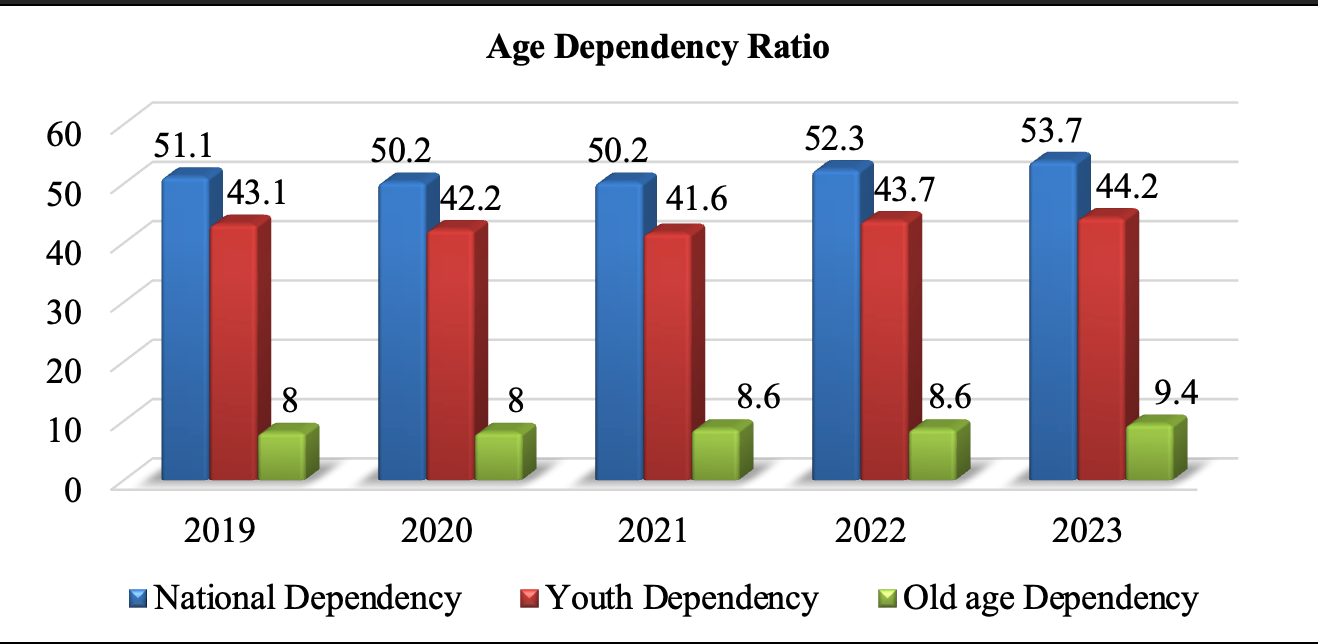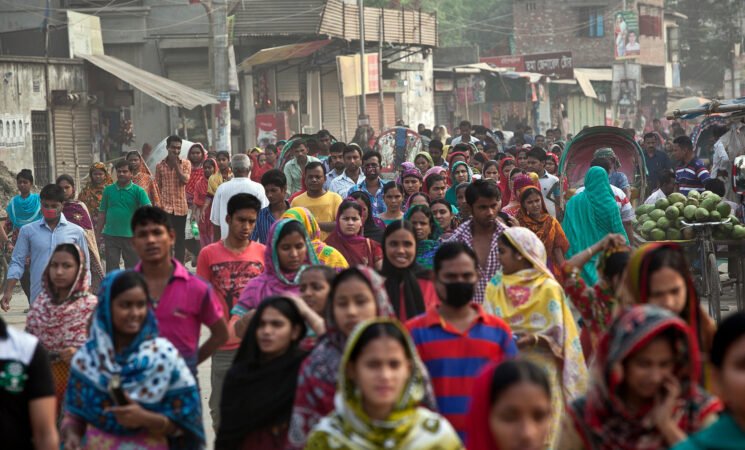5 May 2025, NIICE Commentary 10798
Dr. Md. Abdul Latif
Once celebrated for its youthful population, Bangladesh stands at a critical juncture in its demographic transition. While experts previously positioned the country in the third stage of the Four-Stage Demographic Transition Model—characterised by declining mortality and fertility rates—recent shifts complicate this narrative. Fluctuations in fertility rates, increased international migration, and evolving mortality trends are transforming the population size and age structure.
The effects of fertility changes are evident, particularly in altering the size of the youngest age cohort. In contrast, the impacts of mortality and migration are more intricate, heavily influenced by the existing age distribution. Currently, the rising numbers of young children (ages 0-14) and older adults (ages 65 and above) present both significant social and economic challenges. However, they also offer potential opportunities for growth and development. As a result, Bangladesh faces a demographic dilemma: is it confronting formidable challenges, or is it poised to capitalize on a potential demographic dividend?
Demographic Dividend
According to the United Nations Population Fund (UNFPA), the demographic dividend refers to the economic growth potential that arises from shifts in age structure, particularly when the working-age population (ages 15 to 64) exceeds the non-working-age population (ages 14 and younger, and 65 and older) (UNFPA). This transition can lead to fewer dependents and a larger labor force, allowing an economy to allocate resources more efficiently. As a result, countries can accelerate development and improve the overall prosperity of their citizens.
To effectively harness the demographic dividend, Bangladesh must prioritize sustainable population growth by integrating its expanding workforce into the economy. This involves preventing unemployment and ensuring equitable access to resources and opportunities. By doing so, the country can mitigate the risks of social unrest and promote inclusive development, thus maximizing the benefits of its demographic transition.
Current Demographic Trends
The Bangladesh Bureau of Statistics (BBS) reported in its 2023 Sample Vital Statistics that the population is now 172.92 million, with a 1.33% annual growth rate. The Total Fertility Rate (TFR) rose from 2.04 in 2019-2020 to 2.20 in 2022 but fell to 2.17 in 2023, impacting demographic structures. Since independence, significant labor migration to the Middle East has influenced age structure, with international mobility rising from 2.94 per thousand in 2019 to 8.78 in 2023. This migration can result in reduced birth rates and brain drain, contributing to an aging population. Fluctuating fertility and increased migration affect the age dependency ratio (ADR), which measures non-working individuals against the workforce. Higher fertility and migration may increase dependents and reduce the working-age population, raising the ADR.
The national age dependency ratio has significantly fluctuated over the past five years, influenced by changes in youth dependency and elderly dependency. In 2019, the national dependency ratio was 51.1, remaining stable at 50.2 in 2020 and 2021, before increasing to 52.3 in 2022 and 53.7 in 2023. Youth dependency (ages 0-14) rose from 41.6 to 44.2, while elderly dependency (ages 65+) increased from 8.0 to 9.4 between 2021 and 2023.

Author-prepared Graph; Data Source: Bangladesh Sample Vital Statistics-2023 (BBS, 2024)
Notably, youth dependency remained unchanged from 2019 to 2020, while elderly dependency decreased from 43.1 to 42.2 during the same period. The rise in youth dependency can be attributed to an increase in the total fertility rate (TFR). This higher TFR has boosted age dependency, potentially contributing to economic growth and poverty reduction by shifting family planning preferences towards larger families, as people feel more secure. Meanwhile, advances in healthcare and sanitation have extended lifespans, resulting in a growing elderly.
Regarding mortality, the country has experienced an unusual rise in its crude death rate over the past five years, increasing from 4.9 per thousand in 2019 to 6.1 in 2023, with annual jumps to 5.1 in 2020, 5.7 in 2021, and 5.8 in 2022. The BBS identifies the primary contributors to this increase as non-communicable diseases (NCDs) such as cardiovascular diseases, cancers, chronic respiratory diseases, and diabetes. The Icddrb highlights that a lack of physical activity and unhealthy diets, exacerbated by sedentary lifestyles, unplanned urbanization, and socio-economic factors, increase the risk of mortality from NCDs.
Demographic Transition- Opportunities for Economic Growth
Bangladesh's unique demographic transition presents a dual-edged sword. While an increasing dependency ratio may strain already fragile healthcare systems and social services, jeopardizing economic growth and risking a middle-income trap, it also offers an opportunity to transform demographic challenges into economic advantages. Policymakers must balance the immediate needs of a growing youth population with the care demands of an aging population.
Effective governance and strategic planning are essential for navigating this crossroad. This involves balancing investments in youth development—such as education, vocational training, and healthcare—with resource management for the elderly.
Quality education is crucial for harnessing the potential of the demographic dividend. By equipping young people with the necessary knowledge, skills, and critical thinking abilities, they become better prepared to compete in both national and international job markets. Additionally, integrating science, technology, and artificial intelligence (AI) into the workforce can optimize resources, foster innovation, and enable rapid analysis of vast datasets. This, in turn, supports informed decision-making and ensures quality and consistency, improving efficiency and productivity—key drivers of economic growth. Moreover, access to quality education empowers youth to make informed family planning and reproductive choices, contributing to lower fertility rates and reshaping the demographic landscape.
Enhancing healthcare is equally vital for supporting both the youth and the growing elderly population. This necessitates a shift in healthcare planning from a curative focus to preventative and geriatric care. Investment in social safety nets, pensions, community support programs, and health infrastructure—alongside training healthcare professionals to address the diverse needs of these demographics—will help create a resilient health system capable of supporting Bangladesh's evolving population.
Strategic Recommendations
To fully leverage Bangladesh's demographic potential, it is crucial to invest in education and training aimed at cultivating a skilled workforce. Promoting entrepreneurship, enhancing women's economic participation, and improving governance are vital steps to foster new businesses and create self-employment opportunities. These initiatives will not only stimulate economic growth but also attract foreign investment.
Socio-economic and environmental policies should prioritize public goods—such as parks, community facilities, and public transportation—over private interests. Additionally, implementing affordable and sustainable housing initiatives can significantly enhance living conditions, promote social justice, and improve overall well-being. These efforts will protect vulnerable groups, strengthen social foundations, ensure equitable resource distribution, foster inclusivity, and uphold intergenerational equity.
Moreover, investments in renewable energy and sustainable infrastructure can drive economic diversification, bolster resilience against environmental challenges, and foster proactive communities that address pressing issues. Successful examples from countries like Korea, Singapore, Malaysia, and Vietnam demonstrate how effectively harnessing human capital through education and vocational training can transform demographic shifts into economic growth. Policies that support female workforce participation have also contributed to creating more diverse and inclusive economies.
Lesson Learning for South Asia
Analyzing Bangladesh's demographic challenges and opportunities provides valuable insights for South Asia, especially Nepal. Key recommendations include investing in education and skills training, encouraging women’s economic participation, improving access to financing for entrepreneurship, supporting startups and SMEs, enhancing entrepreneurial skills, strengthening healthcare infrastructure with a focus on preventive and geriatric care, investing in sustainable urban development, managing labor migration, reintegrating returnees, and fostering governance collaboration, data-driven policymaking, and community engagement in environmental sustainability. By implementing these recommendations, Nepal and other South Asian nations can effectively navigate demographic transitions, transforming challenges into opportunities for sustainable economic growth and enhanced social development.
Conclusion
Bangladesh stands at a critical demographic crossroads, where the decisions made today will shape the future for generations to come. Immediate action is essential, as the path the country chooses will determine whether it can capitalize on its demographic dividend or confront the challenges of an unprepared society.
Countries like Nigeria, Egypt, and South Africa share significant youth potential but have faced high youth unemployment and underemployment due to inaction, leading to social unrest and economic stagnation. To avoid a similar fate, Bangladesh must navigate this uncertainty and build resilience through effective collaboration among stakeholders, including the government, civil society, and the private sector. Together, they can address the challenges and seize the opportunities presented by this demographic shift, ultimately ensuring a prosperous future for all citizens.
Dr. Md. Abdul Latif is the Additional Director at Bangladesh Institute of Governance and Management (BIGM), Bangladesh, & a Global Ambassador & ADB-JSP Scholar

